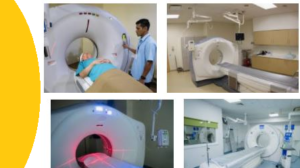Is an CT Scan?

A computerized tomography scan (CT or CAT scan) uses computers and rotating X-ray machines to create cross-sectional images of the body. These images provide more detailed information than normal X-ray images. They can show the soft tissues, blood vessels, and bones in various parts of the body. A CT scan may be used to visualize the:
- head
- shoulders
- spine
- heart
- abdomen
- knee
- chest
During a CT scan, you lie in a tunnel-like machine while the inside of the machine rotates and takes a series of X-rays from different angles. These pictures are then sent to a computer, where they’re combined to create images of slices, or cross-sections, of the body. They may also be combined to produce a 3-D image of a particular area of the body.
Why Is a CT Scan Performed?
A CT scan has many uses, but it’s particularly well-suited for diagnosing diseases and evaluating injuries. The imaging technique can help your doctor:
- diagnose infections, muscle disorders, and bone fractures
- pinpoint the location of masses and tumors (including cancer)
- study the blood vessels and other internal structures
- assess the extent of internal injuries and internal bleeding
- guide procedures, such as surgeries and biopsies
- monitor the effectiveness of treatments for certain medical conditions, including cancer and heart disease
The test is minimally invasive and can be conducted quickly.
How Is a CT Scan Performed?
Your doctor may give you a special dye called a contrast materialto help internal structures show up more clearly on the X-ray images. The contrast material blocks X-rays and appears white on the images, allowing it to highlight the intestines, blood vessels, or other structures in the area being examined. Depending on the part of your body that’s being inspected, you may need to drink a liquid containing the contrast. Alternatively, the contrast may need to be injected into your arm or administered through your rectum via an enema. If your doctor plans on using a contrast material, they may ask you to fast for four to six hours before your CT scan.
When it comes time to have the CT scan, you’ll be asked to change into a hospital gown and to remove any metal objects. Metal can interfere with the CT scan results. These items include jewelry, glasses, and dentures. Your doctor will then ask you to lie face up on a table that slides into the CT scanner. They’ll leave the exam room and go into the control room where they can see you and hear you. You’ll be able to communicate with them via an intercom.
While the table slowly moves you into the scanner, the X-ray machine will rotate around you. Each rotation produces numerous images of thin slices of your body. You may hear clicking, buzzing, and whirring noises during the scan. The table will move a few millimeters at a time until the exam is finished. The entire procedure may take anywhere from 20 minutes to one hour.
It’s very important to lie still while CT images are being taken because movement can result in blurry pictures. Your doctor may ask you to hold your breath for a short period during the test to prevent your chest from moving up and down. If a young child needs a CT scan, the doctor may recommend a sedative to keep the child from moving.
Once the CT scan is over, the images are sent to a radiologist for examination. A radiologist is a doctor who specializes in diagnosing and treating conditions using imaging techniques, such as CT scans and X-rays. Your doctor will follow-up with you to explain the results.
What Are the Risks Associated with a CT Scan?
There are very few risks associated with a CT scan. Though CT scans expose you to more radiation than typical X-rays, the risk of cancer caused by radiation is very small if you only have one scan. Your risk for cancer may increase over time if you have multiple X-rays or CT scans. The risk of cancer is increased in children receiving CT scans, especially to the chest and abdomen.
Some people have an allergic reaction to the contrast material. Most contrast material contains iodine, so if you’ve had an adverse reaction to iodine in the past, make sure to notify your doctor. Your doctor may give you allergy medication or steroids to counteract any potential side effects if you’re allergic to iodine but must be given contrast.
It’s also important to tell your doctor if you’re pregnant. Though the radiation from a CT scan is unlikely to harm your baby, your doctor may recommend another exam, such as an ultrasound or MRI scan, to minimize risk.
What Do CT Scan Results Mean?
CT scan results are considered normal if the radiologist didn’t see any tumors, blood clots, fractures, or other abnormalities in the images. If any abnormalities are detected during the CT scan, you may need further tests or treatments, depending on the type of abnormality found.